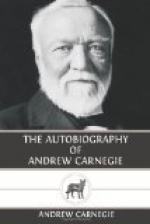It was not, however, all smooth sailing with our iron business. Years of panic came at intervals. We had passed safely through the fall in values following the war, when iron from nine cents per pound dropped to three. Many failures occurred and our financial manager had his time fully occupied in providing funds to meet emergencies. Among many wrecks our firm stood with credit unimpaired. But the manufacture of pig iron gave us more anxiety than any other department of our business so far. The greatest service rendered us in this branch of manufacturing was by Mr. Whitwell, of the celebrated Whitwell Brothers of England, whose blast-furnace stoves were so generally used. Mr. Whitwell was one of the best-known of the visitors who came to marvel at the Lucy Furnace, and I laid the difficulty we then were experiencing before him. He said immediately:
“That comes from the angle of the bell being wrong.”
He explained how it should be changed. Our Mr. Kloman was slow to believe this, but I urged that a small glass-model furnace and two bells be made, one as the Lucy was and the other as Mr. Whitwell advised it should be. This was done, and upon my next visit experiments were made with each, the result being just as Mr. Whitwell had foretold. Our bell distributed the large pieces to the sides of the furnace, leaving the center a dense mass through which the blast could only partially penetrate. The Whitwell bell threw the pieces to the center leaving the circumference dense. This made all the difference in the world. The Lucy’s troubles were over.
What a kind, big, broad man was Mr. Whitwell, with no narrow jealousy, no withholding his knowledge! We had in some departments learned new things and were able to be of service to his firm in return. At all events, after that everything we had was open to the Whitwells. [To-day, as I write, I rejoice that one of the two still is with us and that our friendship is still warm. He was my predecessor in the presidency of the British Iron and Steel Institute.]
CHAPTER XIII
THE AGE OF STEEL
Looking back to-day it seems incredible that only forty years ago (1870) chemistry in the United States was an almost unknown agent in connection with the manufacture of pig iron. It was the agency, above all others, most needful in the manufacture of iron and steel. The blast-furnace manager of that day was usually a rude bully, generally a foreigner, who in addition to his other acquirements was able to knock down a man now and then as a lesson to the other unruly spirits under him. He was supposed to diagnose the condition of the furnace by instinct, to possess some almost supernatural power of divination, like his congener in the country districts who was reputed to be able to locate an oil well or water supply by means of a hazel rod. He was a veritable quack doctor who applied whatever remedies occurred to him for the troubles of his patient.




